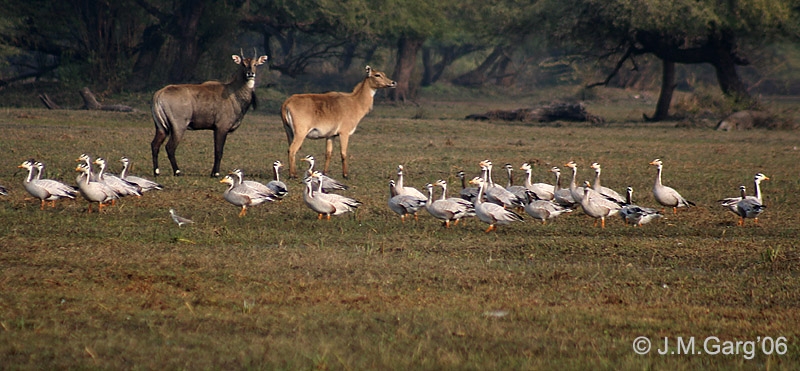Bar-headed Goose
From Wikipedia, the free encyclopedia
[Photo] Bar-headed Goose (Anser indicus) in Bharatpur, Rajasthan, India. Date 3 January 2006. Author J.M.Garg. Copyright (C) 2006 J. M. Garg
Permission is granted to copy, distribute and/or modify this document under the terms of the GNU Free Documentation License, Version 1.2 or any later version published by the Free Software Foundation; with no Invariant Sections, no Front-Cover Texts, and no Back-Cover Texts. A copy of the license is included in the section entitled "GNU Free Documentation License". |
Order: Anseriformes
Family: Anatidae
Species: Anser indicus (Latham, 1790)
Synonyms: Eulabeia indica
The Bar-headed Goose (Anser indicus) is a goose which breeds in Central Asia in colonies of thousands near mountain lakes. It lays 3-8 eggs in a ground nest.
The preferred summer habitat is high altitude lakes where the bird grazes on short grass. It suffers predation from crows, foxes, ravens, sea eagles and others. The total population may, however, be increasing.
The Bar-headed Goose migrates over the Himalayas to spend the winter in India, Assam, Northern Burma and the wetlands of Pakistan. The winter habitat of the Bar-headed Goose is on cultivation, and the bird feeds on barley, rice and wheat, and may damage crops.
The Bar-headed Goose is believed to be the highest flying bird having been seen at up to 10175 m (33,382 feet). It has a slightly larger wing area for its weight than other geese. It is believed this helps the goose to fly so high.
The bird is pale grey, it is easily distinguished from any of the other grey geese of the genus Anser by the character implied by its English name. It is also much paler than the other geese in this genus. In flight, its call is a typical goose honking. It has sometimes been separated from Anser, which has no other member indigenous to the Indian region, nor any at all to the Ethiopian, Australian, or Neotropical regions, and placed in the monotypic genus Eulabeia.
The Bar-headed Goose is often kept in captivity as it is considered beautiful and breeds readily in captivity from which it sometimes escapes. Records in Britain are frequent, and almost certainly relate to escapes - however, the species has bred on several occasions in recent years and around five pairs were recorded in 2002 (the most recent available report of the Rare Birds Breeding Panel). It is possible the species is becoming gradually more established in the UK. The bird is sociable and causes no problems for other birds. The wild population is believed to be declining due to over-hunting.
http://en.wikipedia.org/wiki/Bar-headed_Goose
| The text in this page is based on the copyrighted Wikipedia article shown in above URL. It is used under the GNU Free Documentation License. You may redistribute it, verbatim or modified, providing that you comply with the terms of the GFDL. |
|

